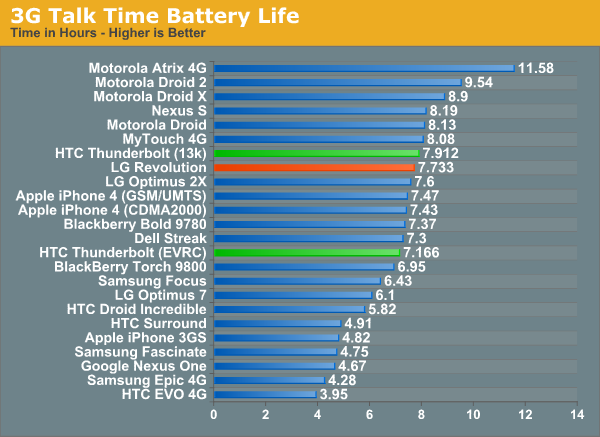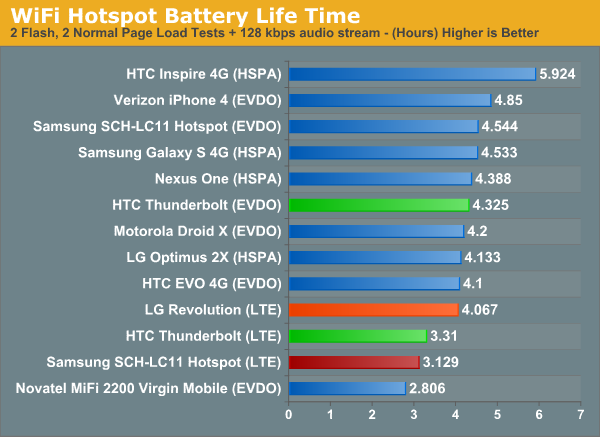LG Revolution: LTE for the Masses
by Vivek Gowri & Brian Klug on June 21, 2011 5:55 AM EST- Posted in
- Smartphones
- Verizon
- LTE
- Mobile
- LG Revolution
LTE battery life, like we saw in the Thunderbolt, is not so hot. It’s better than the TB, partially because the battery is slightly larger (5.6 Wh versus 5.18 Wh in the TB, so about 8% difference). The rest of the difference can be put down to the other main components at work here - the L2000 modem and the screen. Using the Revolution as an LTE hotspot is again a bit better than the Thunderbolt, suggesting that most of the difference is in the modem.




Even though it’s better, that’s still not saying very much. It’s very much in the bottom 10-20% in our benchmarks for battery life under LTE, and while the picture gets better under EVDO, it still doesn’t manage to break 4 hours of web browsing life. Battery performance under WiFi is dramatically better, putting it right between the Optimus 2X and the Thunderbolt and in the same range as the rest of the 4.3” smartphone class. Same goes for talk time, since Verizon is still only using CDMA2000 for voice calls.
But let’s go back to LTE for a moment. Here’s the problem with all of the real 4G devices (LTE and WiMAX only, HSPA+ doesn’t count here). You can’t really use the 4G part of it for very long if you want your device to live through a day. Where that becomes compounded is that with the Verizon devices, there’s no easy way to switch from EVDO to LTE and back. You have to actually sit through and reboot the phone if you want to turn LTE on or off on the LG Revolution. Sprint is much easier, there’s actually a software switch to turn WiMAX on or off, similar to GPS or WiFi on most normal Android phones. It’s a big problem for Verizon, one that I suspect won’t get solved until the LTE modem gets integrated onto the SoC. Qualcomm has one such SoC in the pipeline, the MSM8960, which is built around an entirely new architecture, krait (as opposed to scorpion), and has an LTE modem onboard in addition to all the usual cellular accouterments from 3GPP and 3GPP2. That’s one I’m really looking forward to, but until then, I suspect it’s going to be tough to get an LTE device through a full day on a single charge without an extended battery.










24 Comments
View All Comments
antef - Tuesday, June 21, 2011 - link
I believe even streaming video will not make use of anything > 5 Mbps or even less. HD Netflix on a PC only requires about 5-6 and I don't think you're getting that same 1080 resolution from the Netflix app on the phone. So I really don't see what good > 5 Mbps is on a phone unless you're tethering to a computer and doing downloads on that.name99 - Wednesday, June 22, 2011 - link
I don't want to be cruel but, good god, you are stupid.What these devices enable is
(a) substantially more CONSISTENT performance across a cell. Instead of the maddening variability of the current system, you should, much more often, get decent performance even at the edge of a cell.
Unfortunately, the one place you'd most like to have this is with voice, and it seems that our oh-so-sophisticated cellular overloads can't get their act together enough to move their voice transmission onto 21st century technology. Perhaps if we're lucky, this will happen sometime before 2025.
(b) somewhat better usage of the limited bandwidth available (ie a larger aggregate bandwidth for the entire cell), which in turn means that in places where, right now, data can be so slow as to be useless, data will now perform somewhat better.
Once again, this likewise has implications for voice meaning, for example, that (once the cell companies get their act together) there will be less need to drop to the low bit rate (and really crappy sounding) codecs.
One can understand why the cell companies talk up 4G speeds. The numbers are easily understood as meaning "better than now", and discussing them does not mean having to concede "yes, our current systems are inconsistent, frequently overloaded, and have crappy voice".
There is rather less justification for why ARS obsesses about these peak speeds, rather than discussing the actual issues that 4G technologies improve --- aggregate bandwidth and signal consistency.
Omega215D - Tuesday, June 21, 2011 - link
I have a stock Thunderbolt and I see better battery life than what's indicated here and I live in NYC. Moderate usage gives me 18 hours of life while constant internet pegging brings me down to 5 - 7 hours all on LTE. I've never experienced intermittent LTE signals when here or traveling (to other LTE cities) either.LTE makes sense for quick pull ups of sites when on the road, like restuarants/ eateries, or for my future plans of video calling my friends who are moving overseas while I make my move to the west coast.
Also I am grandfathered into Unlimited Data in which I am happy that I got my T-bolt when I did.
PCTC2 - Tuesday, June 21, 2011 - link
Just letting you know there's a typo. Nothing big."Brian saw LTE speeds clustered around 10 Mbps down and 2-3 Mbps down."
Isn't the second one supposed to say "up"?
As for 4G, I would appreciate the speed even remotely close as I barely get 1 Mbps down, 0.2 Mbps up, but I guess I can't complain because 80% of my day is spent in WiFi coverage anyways.
VivekGowri - Tuesday, June 21, 2011 - link
Fiiiiiixed :)Lolimaster - Tuesday, June 21, 2011 - link
Now Anand, remove sysmark from your cpu benchmark, it's now a useless biased bench. We all know that except "some" sites.http://semiaccurate.com/2011/06/20/nvidia-amd-and-...
bluelite - Tuesday, June 21, 2011 - link
Wait. Isn't this the same engine as the one on my over year old Incredible ? And LTE is nice. IF it is available at your location. It's not available here. Suffolk County Long Island.Omid.M - Tuesday, June 21, 2011 - link
I picked up a used Thunderbolt for $330. That included shipping, 5 batteries, two chargers, case & holster, and screen protector.Why did I do this? I dislike the phone itself but this was the fastest way to secure unlimited 4G before tiered plans come (likely early July). I will use the Bolt until a phone based on Krait comes to market. I hope HTC releases something like the Sensation for Verizon, based on Krait and with a qHD/SLCD display. I want the Galaxy S2 but I doubt it'll have LTE. There's just no way.
Yes, I would buy my next phone off contract to avoid locking myself into a contract with new terms (i.e. tiered data plans).
Mr Perfect - Tuesday, June 21, 2011 - link
Could you test out the camera's macro mode? One of the main things I use my phone's camera for is taking pictures of small parts and labels, things like product and serial numbers, connectors and those little bits that people always manage to break off of devices. My current phone is OK at best, usually requiring some trial and error with things like distance, flash and focus. Thanks!Impulses - Tuesday, June 21, 2011 - link
"this is a huge peeve of mine with the HD7, iPod touch, and anything Samsung makes - bottom-mounted headphone jacks and side-located power buttons are stupid."Wow, I strongly disagree on both counts... I know a lot of people prefer the top mounted headphone jack because it's easier to hold the device this way with headphones plugged in, but I generally listen to music with the phone in my pocket... I also tend to slip it into my pocket upside down so that when I slide my palm over it and take it out the device is already right side up. However that's impossible to do with headphones plugged into a top mounted jack, unless the headphones have an L plug (and even then it's awkward).
It might be a different story for people with thinner phones or pockets (i guess they'd pinch the screen or the sides to slide it out, which always felt precarious with my EVO)... It's a pretty personal thing I guess.
The side power button isn't as personal a matter tho, imo. I've got fairly long fingers and after a year with an EVO I don't see why anyone prefers it up top on any 4.3"phone, no matter how you hold the phone it requires an awkward finger reach to press... Samsung's side mounted lock button seems like the way to go imo. Even better would be a front button that wakes up the device, I like capacitive buttons better but I do miss the ability to easily wake it while it's laying down (without gripping it to press a side button).
Surely there's gotta be an ingenious solution that combines all the pro's and con's... At least most Android devices are coming with notification lights.